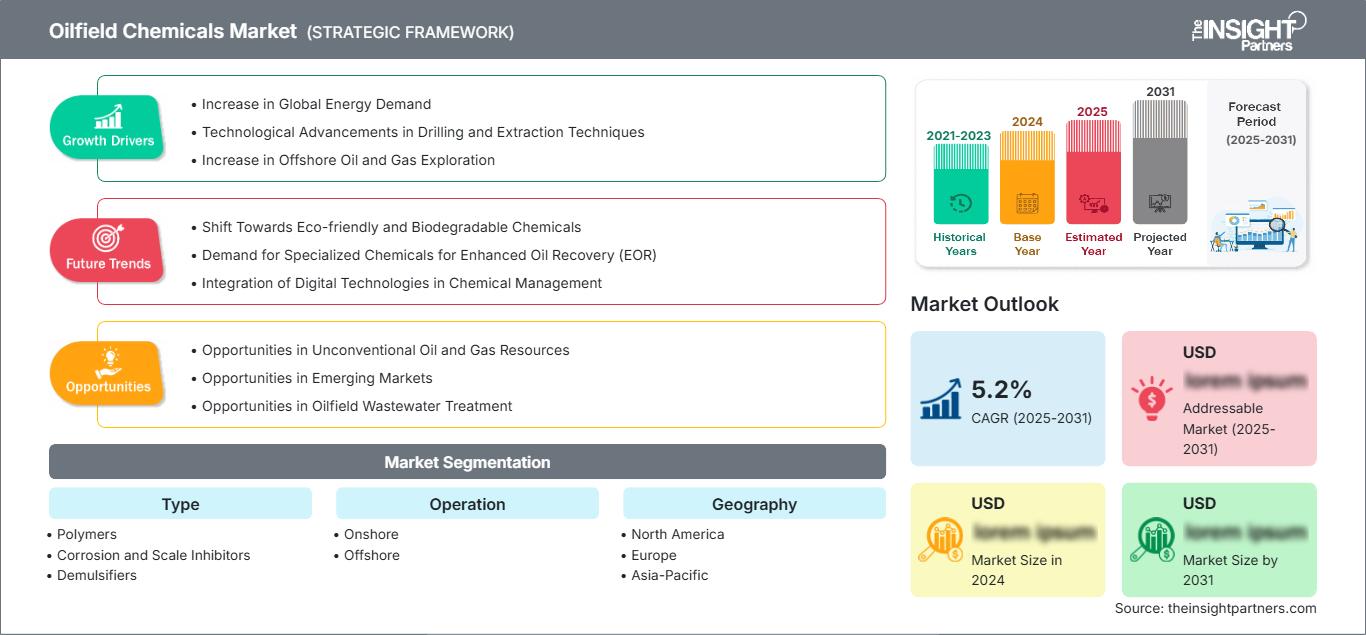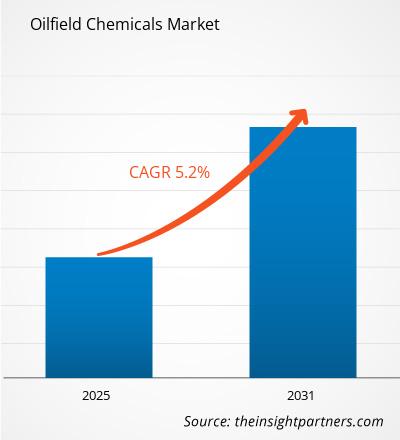Der Markt für Ölfeldchemikalien wird bis 2031 voraussichtlich ein Volumen von 36,56 Milliarden US-Dollar erreichen. Für den Zeitraum 2025–2031 wird ein jährliches Wachstum von 3,8 % erwartet.
Der Bericht ist nach Produkttyp (Polymere, Korrosions- und Ablagerungsinhibitoren, Demulgatoren, Biozide, Reibungsminderer, Flockungsmittel und Koagulationsmittel, Additive zur Reduzierung von Flüssigkeitsverlusten und Sonstige) segmentiert. Zudem erfolgt eine Segmentierung nach Betriebsart (Onshore, Offshore) und Anwendung (Bohren, Zementieren, Produktion, verbesserte Ölgewinnung, Stimulation und Sonstige). Der Bericht umfasst fünf Regionen: Nordamerika, Europa, Asien-Pazifik, Naher Osten und Afrika sowie Süd- und Mittelamerika und die wichtigsten Länder jeder Region. Die globale Analyse wird weiter auf regionaler Ebene und für die wichtigsten Länder aufgeschlüsselt. Der Bericht gibt den Wert der oben genannten Analysen und Segmente in USD an.
Zweck des Berichts
Der Bericht „Ölfeldchemikalienmarkt“ von The Insight Partners beschreibt die aktuelle Marktlage und das zukünftige Wachstum, die wichtigsten Triebkräfte, Herausforderungen und Chancen. Er bietet Einblicke für verschiedene Akteure im Markt, wie z. B.:
- Technologieanbieter/Hersteller: Um die sich entwickelnde Marktdynamik zu verstehen und potenzielle Wachstumschancen zu erkennen, können sie fundierte strategische Entscheidungen treffen.
- Investoren: Um eine umfassende Trendanalyse hinsichtlich Marktwachstumsrate, Finanzprognosen und Chancen entlang der Wertschöpfungskette durchzuführen.
- Regulierungsbehörden: Um Richtlinien zu regulieren und Aktivitäten auf dem Markt zu überwachen, mit dem Ziel, Missbrauch zu minimieren, das Vertrauen der Investoren zu wahren und die Integrität und Stabilität des Marktes zu gewährleisten.
Marktsegmentierung für Ölfeldchemikalien Typ
- Polymere
- Korrosions- und Ablagerungsinhibitoren
- Demulgatoren
- Biozide
- Reibungsminderer
- Flockungsmittel und Koagulationsmittel
- Zusätze zur Reduzierung von Flüssigkeitsverlusten
Anwendung
- Onshore
- Offshore
Sie erhalten kostenlos Anpassungen an jedem Bericht, einschließlich Teilen dieses Berichts oder einer Analyse auf Länderebene, eines Excel-Datenpakets sowie tolle Angebote und Rabatte für Start-ups und Universitäten.
Markt für Ölfeldchemikalien: Strategische Einblicke

- Holen Sie sich die wichtigsten Markttrends aus diesem Bericht.Dieses KOSTENLOSE Beispiel umfasst Datenanalysen, die von Markttrends bis hin zu Schätzungen und Prognosen reichen.
Wachstumstreiber des Marktes für Ölfeldchemikalien
- Steigende globale Energienachfrage: Die wachsende globale Energienachfrage, insbesondere nach Öl und Gas, ist ein wesentlicher Treiber für den Markt für Ölfeldchemikalien. Da die Explorations- und Produktionsaktivitäten zur Deckung des Energiebedarfs intensiviert werden, sind Ölfeldchemikalien entscheidend für die Verbesserung der Bohreffizienz, die Steigerung der Produktion und das Management der Lagerstättenbedingungen. Diese Nachfrage nach Öl- und Gasprodukten treibt den Bedarf an verschiedenen Chemikalien an, die in Explorations-, Förder- und Raffinerieprozessen eingesetzt werden.
- Technologische Fortschritte bei Bohr- und Fördertechniken: Innovationen bei Bohrtechnologien wie dem hydraulischen Fracking und dem Horizontalbohren haben die Effizienz der Öl- und Gasförderung erhöht. Diese fortschrittlichen Fördermethoden sind stark auf den Einsatz spezialisierter Ölfeldchemikalien angewiesen, die die Leistung verbessern, die Umweltbelastung reduzieren und die Sicherheit und Langlebigkeit der Anlagen gewährleisten. Die kontinuierliche Weiterentwicklung der Bohrtechniken treibt das Wachstum des Marktes für Ölfeldchemikalien voran. Zunahme der Offshore-Öl- und -Gasexploration: Die Verlagerung hin zur Tiefsee- und Offshore-Ölexploration beschleunigt sich und erfordert spezialisierte Ölfeldchemikalien, die auch unter extremen Umweltbedingungen zuverlässig funktionieren. Offshore-Projekte benötigen Chemikalien zur Steigerung der Ölgewinnung, zum Korrosionsschutz und für Bohrflüssigkeiten. Die wachsende Zahl von Offshore-Projekten trägt somit zur erhöhten Nachfrage nach spezialisierten Ölfeldchemikalien in diesen anspruchsvollen Umgebungen bei. Zukunftstrends im Markt für Ölfeldchemikalien: Hinwendung zu umweltfreundlichen und biologisch abbaubaren Chemikalien: Aufgrund zunehmender Umweltbedenken und strengerer Vorschriften ist ein Trend hin zur Verwendung umweltfreundlicher und biologisch abbaubarer Ölfeldchemikalien zu beobachten. Unternehmen der Öl- und Gasindustrie konzentrieren sich darauf, ihren ökologischen Fußabdruck zu verringern, und der Einsatz umweltfreundlicherer Chemikalien für Bohr-, Produktions- und Aufbereitungsprozesse gewinnt an Bedeutung. Diese Entwicklung fördert die Entwicklung und Anwendung nachhaltiger Alternativen auf dem Markt für Ölfeldchemikalien. Nachfrage nach Spezialchemikalien für die verbesserte Erdölförderung (EOR): Angesichts der Erschöpfung konventioneller Erdölreserven ist ein steigender Trend bei Verfahren zur verbesserten Erdölförderung (EOR) zu beobachten. Diese Verfahren basieren auf dem Einsatz von Spezialchemikalien wie Tensiden, Polymeren und Lösungsmitteln. Sie dienen der Verbesserung der Erdölgewinnung aus erschöpften Feldern. Das Wachstum der EOR-Aktivitäten treibt die Nachfrage nach Ölfeldchemikalien an, die die Effizienz und Effektivität dieser Förderprozesse steigern. Integration digitaler Technologien im Chemikalienmanagement: Die Öl- und Gasindustrie integriert zunehmend digitale Technologien wie Datenanalysen und IoT-basierte Systeme in ihre Chemikalienmanagementprozesse. Diese Technologien tragen dazu bei, den Chemikalieneinsatz zu optimieren, die Chemikalienbedingungen in Echtzeit zu überwachen und Abfall zu reduzieren. Mit fortschreitender Digitalisierung profitiert der Markt für Ölfeldchemikalien von Fortschritten, die Effizienz, Leistung und Kostenmanagement in chemischen Anwendungen verbessern.
Marktchancen für Ölfeldchemikalien
- Chancen bei unkonventionellen Öl- und Gasressourcen: Die Exploration und Produktion unkonventioneller Öl- und Gasressourcen wie Schieferöl und -gas eröffnen dem Markt für Ölfeldchemikalien bedeutende Chancen. Diese Ressourcen erfordern Spezialchemikalien für das hydraulische Fracking, die Bohrlochstimulation und die Produktionssteigerung. Mit der weltweit zunehmenden Exploration unkonventioneller Ressourcen steigt die Nachfrage nach Chemikalien, die auf diese spezifischen Anwendungen zugeschnitten sind.
- Chancen in Schwellenländern: Der steigende Energieverbrauch in Schwellenländern, insbesondere im asiatisch-pazifischen Raum, in Lateinamerika und im Nahen Osten, bietet dem Markt für Ölfeldchemikalien erhebliche Wachstumschancen. Mit der Ausweitung der Öl- und Gasexploration in diesen Regionen steigt die Nachfrage nach einer breiten Palette von Chemikalien für Bohrung, Produktion und Lagerstättenmanagement. Dieses Wachstum wird neue Märkte für Hersteller von Ölfeldchemikalien eröffnen.
- Chancen in der Ölfeldabwasserbehandlung: Die Öl- und Gasindustrie steht vor Herausforderungen im Bereich des Abwassermanagements. Ölfeldchemikalien sind unerlässlich für die Behandlung und das Recycling von Abwasser während der Explorations- und Produktionsaktivitäten. Chemikalien zur Wasseraufbereitung, wie Flockungsmittel und Biozide, spielen eine entscheidende Rolle für die Erhaltung der Wasserqualität und die Minimierung der Umweltbelastung. Angesichts zunehmender Regulierungen und des Bedarfs an nachhaltigen Verfahren dürfte die Nachfrage nach Ölfeldchemikalien in der Abwasserbehandlung steigen.
Ölfeldchemikalienmarkt
Die regionalen Trends und Einflussfaktoren auf den Markt für Ölfeldchemikalien im gesamten Prognosezeitraum wurden von den Analysten von The Insight Partners ausführlich erläutert. Dieser Abschnitt behandelt außerdem die Marktsegmente und die geografische Verteilung des Marktes für das Management von Herzrhythmusstörungen in Nordamerika, Europa, Asien-Pazifik, dem Nahen Osten und Afrika sowie Süd- und Mittelamerika.
Umfang des Marktberichts zu Ölfeldchemikalien
| Berichtsattribut | Einzelheiten |
|---|---|
| Marktgröße in 2024 | US$ XX Billion |
| Marktgröße nach 2031 | US$ 36.56 Billion |
| Globale CAGR (2025 - 2031) | 3.8% |
| Historische Daten | 2021-2023 |
| Prognosezeitraum | 2025-2031 |
| Abgedeckte Segmente |
By Typ
|
| Abgedeckte Regionen und Länder | Nordamerika
|
| Marktführer und wichtige Unternehmensprofile |
|
Dichte der Marktteilnehmer im Bereich Ölfeldchemikalien: Auswirkungen auf die Geschäftsdynamik
Der Markt für Ölfeldchemikalien wächst rasant, angetrieben durch die steigende Nachfrage der Endverbraucher. Gründe hierfür sind unter anderem sich wandelnde Verbraucherpräferenzen, technologische Fortschritte und ein wachsendes Bewusstsein für die Vorteile des Produkts. Mit steigender Nachfrage erweitern Unternehmen ihr Angebot, entwickeln innovative Lösungen, um den Verbraucherbedürfnissen gerecht zu werden, und nutzen neue Trends, was das Marktwachstum zusätzlich beflügelt.

- Holen Sie sich die Markt für Ölfeldchemikalien Übersicht der wichtigsten Akteure
Wichtigste Verkaufsargumente
- Umfassende Abdeckung: Der Bericht bietet eine umfassende Analyse der Produkte, Dienstleistungen, Typen und Endnutzer des Marktes für Ölfeldchemikalien und vermittelt so ein ganzheitliches Bild.
- Expertenanalyse: Der Bericht basiert auf dem fundierten Wissen von Branchenexperten und Analysten.
- Aktuelle Informationen: Der Bericht gewährleistet Geschäftsrelevanz durch die Berücksichtigung aktueller Informationen und Datentrends.
- Anpassungsmöglichkeiten: Dieser Bericht kann an spezifische Kundenanforderungen angepasst werden und sich optimal in die Geschäftsstrategien integrieren.
Der Forschungsbericht zum Markt für Ölfeldchemikalien kann somit maßgeblich dazu beitragen, das Branchenszenario und die Wachstumsaussichten zu entschlüsseln und zu verstehen. Auch wenn einige berechtigte Bedenken bestehen, überwiegen die Vorteile dieses Berichts insgesamt die Nachteile.
- Historische Analyse (2 Jahre), Basisjahr, Prognose (7 Jahre) mit CAGR
- PEST- und SWOT-Analyse
- Marktgröße Wert/Volumen – Global, Regional, Land
- Branchen- und Wettbewerbslandschaft
- Excel-Datensatz
Aktuelle Berichte
Verwandte Berichte
Erfahrungsberichte
Grund zum Kauf
- Fundierte Entscheidungsfindung
- Marktdynamik verstehen
- Wettbewerbsanalyse
- Kundeneinblicke
- Marktprognosen
- Risikominimierung
- Strategische Planung
- Investitionsbegründung
- Identifizierung neuer Märkte
- Verbesserung von Marketingstrategien
- Steigerung der Betriebseffizienz
- Anpassung an regulatorische Trends






















 Kostenlose Probe anfordern für - Markt für Ölfeldchemikalien
Kostenlose Probe anfordern für - Markt für Ölfeldchemikalien